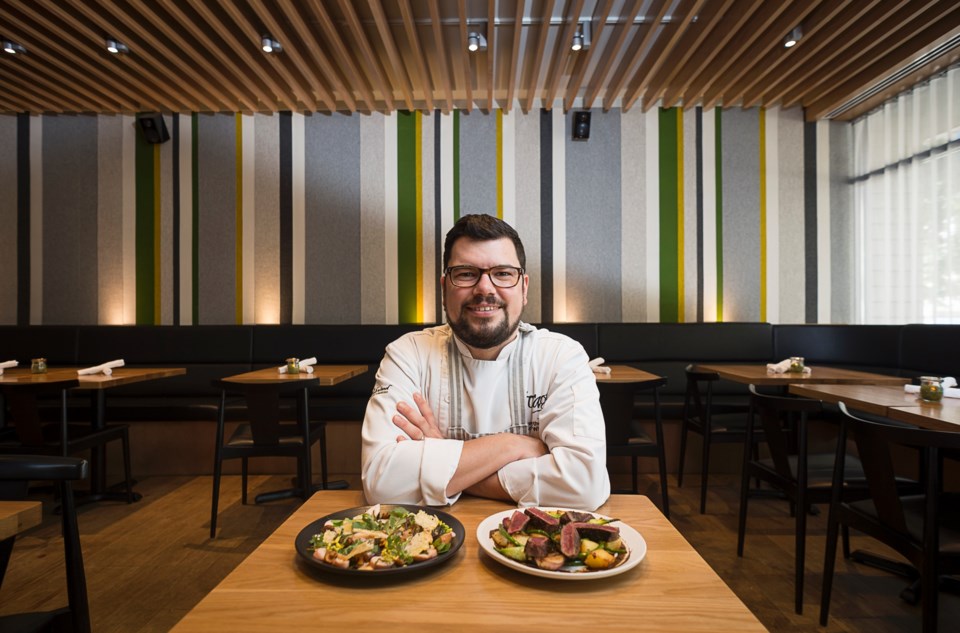Not long ago, this was the neighbourhood where elegantly-dressed ladies would get chauffeured around to tea rooms and clothing shops, and gentlemen would drive around in their custom automobiles. Think I’m talking about Shaughnessy? Think again.
The West End, back at the end of the 19th century, was where the rich and powerful came to live and play, and the Robson/Davie/Denman triangle was their mecca. By the time the Second World War had come to a close, the West End’s many mansions had mostly been divided up as rooming houses for migrant workers and those of limited means. A second boom in the ‘50s saw the growth of high rises and, later, the traffic calming that made this one of the most pedestrian-friendly areas in Greater Vancouver.
That boom also saw the rise of the West End’s casual restaurant scene, with small ethnic eateries dominating the gastronomic line-up. Those little holes-in-the-wall are still thriving today, places like Hokkaido Santouka Ramen, Motomachi Shokudo, Zakkushi, Damso, Legendary Noodle and a host of others. And, lest you think it’s all about the izakaya and noodles, let’s not forget La Belle Patate, Joe’s Grill and the score of public houses that have come and gone along all three thoroughfares. This became the culinary language of the West End for decades; a destination for casual sushi nights or hearty plates at Stepho’s, grand poohbah of cheap Greek fare. While the idea of fine dining in the West End at the time was almost laughable, these weren’t the only options.
In the late ‘70s, Jean-Luc Bertrand and Pierre Dubrulle (yes, of Dubrulle culinary school fame) opened up Le Gavroche in the heritage house on Alberni. A couple years later, Manuel Ferreira came on as a consultant, and eventually took over the business in the mid-‘80s. In 1983, Michel Jacob opened up his legendary Le Crocodile, which became (and still is) the byword for French haute cuisine in Vancouver. Higher-end establishments like the Raintree, which opened in the late ‘80s, were turning out local and sustainable cuisine, à la John Bishop in Kitsilano, long before “locavore” was an actual word. Chefs like Karen Barnaby (Raintree, and later, The Fish House) were making names for themselves in this casual corner by the sea. Central Bistro, right across from English Bay, was turning out European comfort food without the “elevated” moniker (and still does, along with Sunday night jazz).
By the early ‘90s, Harry Kambolis had opened his ground-breaking Raincity Grill (closed as of last year), with its 100-mile philosophy and exclusively-BC wine list (revolutionary at the time). In the late ‘90s, it was Tapastree, the brilliant creation from Nicole Welsh and Mike Jeffs, which served up fine dining tapas and was quickly followed by the likes of Bin 941 on Davie. Around the same time, Kambolis opened his second operation, the legendary C Restaurant, with its 100 per cent sustainable seafood menu and equally earth-friendly wine list.
All of a sudden, the West End was the place to look to for innovation and up-and-coming talent. Just look who came out of some of these kitchens over the last two decades of the 20th century: Robert Clark (co-owner, The Fish Counter and one of the founding member of Ocean Wise); Tom Doughty and Robert Belcham (owners, Campagnolo, Campagnolo Roma); Rob Feenie (executive chef; Cactus Club); David Hawksworth (owner/chef, Hawksworth, Bel Café); John Blakeley (owner, Bistro Pastis, Left Bank); Andrea Carlson (owner, Burdock & Co); Annette Rawlinson (co-owner, Service Excellence); Sean Cousins (executive chef, Vancouver Club); JC Poirier (owner/chef, Ask for Luigi, Pizzeria Farina); Quang Dang (executive chef, West); Lee Humphries (executive chef, Burrowing Owl); Mark Taylor (owner, Siena); Jennifer Peters (owner, NextJen Gluten-Free); and many, many more.
Then, 2008 happened and fine dining took a nosedive. Good food, however, did not.
Brothers Stephen and Michael Wiese opened their still-popular Franco-German restaurant, La Brasserie, and became famous for their spätzle and suckling pig. While Raincity and C saw the beginning of the struggles that led to their eventual closings last year, other, more casual spots took their place in prominence.
The rise of the casual bistro/trattoria started here in the West End.
Tapastree owners Welsh and Jeffs opened pizza-forward Nook right around the corner on Denman in 2009, and a year later, transformed Tapastree into Tavola, a casual Italian eatery that focused on share plates. By 2012, chef Neil Taylor and front-of-house veteran Ed Perrow had opened the wildly successful España, with its Spanish-themed tapa and sherry list (their British gastropub, The Fat Badger, followed last year in the old Le Gavroche space). Meanwhile, chef Chris Whittaker transformed O’Doul’s in the Listel on Robson into Forage, one of the greenest rooms in the city.
Today, the West End is a happy mishmash of fine dining, “upscale-casual,” and casual eateries, representing almost every region and culture imaginable within a few square miles. It’s still an incubator for new talent and ideas, and, yes, a great place for a bowl of ramen on a rainy Friday night.




